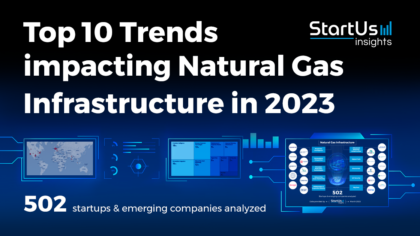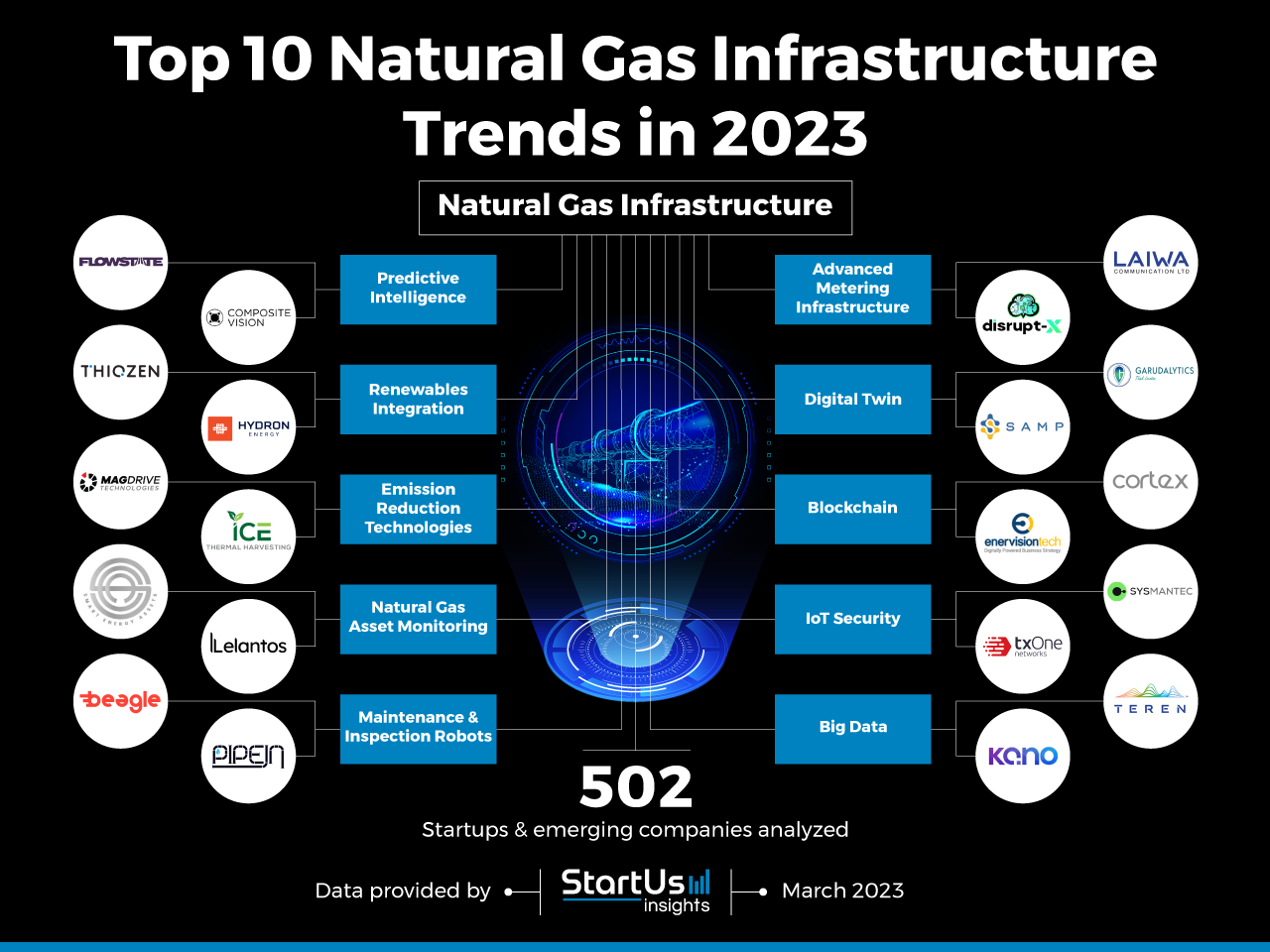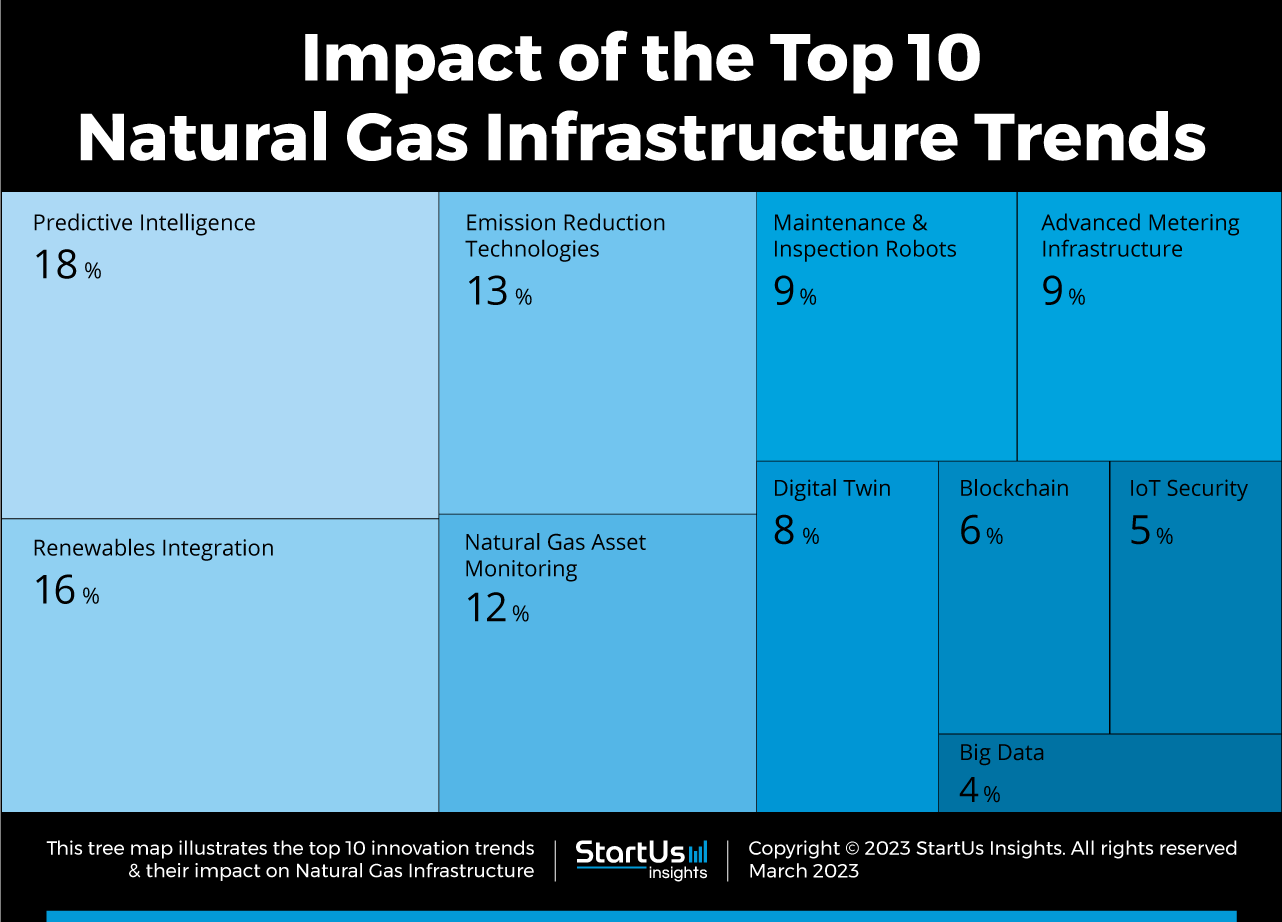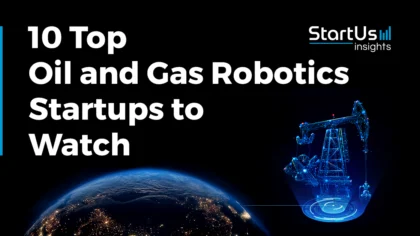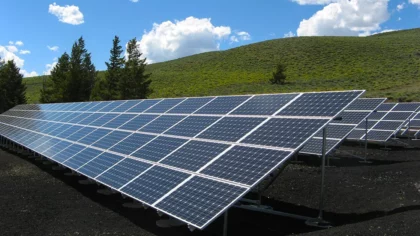Accelerate Productivity in 2025
Reignite Growth Despite the Global Slowdown
The natural gas infrastructure sector needs to constantly manage and tackle challenges such as aging pipelines, increasing demands, fluctuating prices, and regulatory challenges forced by climate change. The integration of advanced technologies such as the internet of things (IoT), artificial intelligence (AI), machine learning, and robotics enable effective monitoring, automation, and optimization of the natural gas supply chain. The automation of many of the manual processes involved in gas extraction, transportation, and distribution reduces costs and also improves worker safety in hazardous work areas. This data-driven research provides you with the top 10 global natural gas infrastructure trends in 2023 based on our research on 502 startups and scaleups.
Innovation Map outlines the Top 10 Trends impacting Natural Gas Infrastructure & 20 Promising Startups
For this in-depth research on the Top 10 Natural Gas Infrastructure Trends & Startups, we analyzed a sample of 502 global startups & scaleups. This data-driven research provides innovation intelligence that helps you improve strategic decision-making by giving you an overview of emerging technologies in the energy industry. In the Natural Gas Infrastructure Innovation Map below, you get a comprehensive overview of the innovation trends & startups that impact your company.
These insights are derived by working with our Big Data & Artificial Intelligence-powered StartUs Insights Discovery Platform, covering 3 790 000+ startups & scaleups globally. As the world’s largest resource for data on emerging companies, the SaaS platform enables you to identify relevant technologies and industry trends quickly & exhaustively.
Tree Map reveals the Impact of the Top 10 Natural Gas Infrastructure Trends
Based on the Natural Gas Innovation Map, the TreeMap below illustrates the impact of the Top 10 Natural Gas Infrastructure Trends in 2023. Startups and scaleups develop data-driven solutions capitalizing on the predictive capabilities of AI and machine learning to optimize natural gas sector processes. Renewable integration reduces the dependence on fossil-based energy sources. Further, asset monitoring and remote inspection technologies streamline operations and improve visibility into the smallest of equipment. Finally, advanced metering infrastructure and big data facilitate the superior handling of information that spearheads better decision-making.
Top 10 Natural Gas Infrastructure Trends
- Predictive Intelligence
- Renewables Integration
- Emission Reduction Technologies
- Asset Monitoring
- Remote Monitoring and Inspection
- Advanced Metering Infrastructure (AMI)
- Digital Twin
- Blockchain
- IoT Security
- Big Data
Global Startup Heat Map covers 502 Natural Gas Infrastructure Startups & Scaleups
The Global Startup Heat Map below highlights the global distribution of the 502 exemplary startups & scaleups that we analyzed for this research. Created through the StartUs Insights Discovery Platform, the Heat Map reveals high startup activity in the US and Europe, followed by India and Singapore. Below, you get to meet 20 out of these 502 promising startups & scaleups as well as the solutions they develop. These gas infra startups are hand-picked based on criteria such as founding year, location, funding raised, & more. Depending on your specific needs, your top picks might look entirely different.
Top 10 Natural Gas Infrastructure Trends for 2023
1. Predictive Intelligence
Predictive intelligence is a valuable tool for enhancing gas infrastructure maintenance and optimization routines. Through advanced analytical techniques, such as machine learning algorithms, patterns in sensor data from gas pipelines are identified to predict potential equipment failures before they occur. This proactive approach minimizes downtime and reduces maintenance costs. Additionally, predictive intelligence optimizes maintenance schedules by using historical data and real-time monitoring to predict when equipment is likely to fail. By only performing necessary maintenance, gas companies reduce costs and minimize intermissions. Overall, predictive intelligence streamlines gas infrastructure’s operational efficiency and safety.
Flowstate provides Pipeline Leak Predictions
US-based startup Flowstate develops a predictive tool to enable early identification of pipeline leaks. The startup’s platform collects data from the field sensors and uses machine learning to predict the corresponding output flow. Comparing this prediction with the actual output pipeline data within the deep learning model leads to the identification of leaks or possible risks. The solution provides pipeline operators with real-time data models to detect anomalies and identify possible leak scenarios. As a result, it enables accurate and timely alerts while diminishing the number of false alarms for operators.
Composite Vision enables Early Defect Detection
German startup Composite Vision offers a software solution that processes non-destructive evaluation (NDE) data using automated AI-backed algorithms. The startup’s solution identifies structural defects in composites and other materials with non-destructive testing (NDT) methods for crucial parts in aerospace, automotive, and energy. This includes oil and gas pipelines that are subject to periodic NDT inspections. Composite Vision’s solution enables the early identification of potential deficiencies avoiding fatal incidents and expensive repairs for asset owners.
2. Renewables Integration
Integrating renewable energy sources into gas infrastructure has become increasingly important to achieve energy sustainability. Renewable integration commonly involves using renewable gases, such as biomethane and hydrogen, as well as gas as a backup for intermittent renewable sources. Additionally, the use of gas as a backup source of energy during intermittent periods of wind and solar production ensures reliable energy supplies. Therefore, renewable integration in gas infrastructure is a significant step towards a more decarbonized future.
Thiozen generates Green Hydrogen from Sour Gas
US-based startup Thiozen develops a separation technology that generates low-cost and low-emission hydrogen from sour gases. The startup’s process captures hydrogen from water and hydrogen sulfide present in sour gas streams. The generated green hydrogen serves as a clean source of energy for natural gas processing, biorefining, and fuel refining replacing fossil fuel alternatives. Besides, Thiozen’s technology produces elemental sulfur as a byproduct, providing an additional revenue stream to gas processing facilities.
Hydron produces Renewable Natural Gas (RNG)
Canadian startup Hydron offers clean fuel solutions that assist hard-to-decarbonize sectors in meeting future energy demands and net-zero goals. The startup’s Intensified Regenerative Upgrading Platform Technology (INTRUPT) is an adsorption-based system that upgrades biogas from organic wastes into renewable natural gas. Hydron’s rapid cycle regenerative process and proprietary nanomaterials overcome the inherent disadvantages of conventional biogas upgrading technologies with lower capital and operating expenditures. This way, INTRUPT facilitates the onsite production of RNG for local fueling needs or virtual pipeline systems.
3. Emission Reduction Technologies
Emission reduction technologies play a critical role in natural gas infrastructure and utilities. Such solutions lower the environmental impact of natural gas production, transportation, and consumption. Technologies such as carbon capture and storage, fugitive emission reduction, and fuel cell technologies significantly reduce GHG emissions, improve energy efficiency, and support the transition to low-carbon energy systems. These technologies not only benefit the environment but also provide economic benefits by multiplying the efficiency and sustainability of natural gas operations, promoting innovation, and creating new job opportunities in the energy sector.
MagDrive eliminates Fugitive Emissions
US-based startup Magdrive develops a magnetically actuated valve drive that eliminates fugitive emissions. The startup’s patented technology seals the valve stem in a solid wall chamber that avoids potential gas leak paths to the environment. Additionally, Magdrive’s actuation system is capable of producing the torque required to operate valves of any size. The scalable solution, in this way, reduces pressure and resource losses, along with eradicating costly fines related to hazardous leaks.
ICE Thermal Harvesting provides Zero Emission Power Solutions
US-based startup ICE Thermal Harvesting leverages heat-to-power technology to generate emission-free electricity. The startup’s power generation solution harvests waste heat from operations such as refining, midstream processing, and compressing. Additionally, the modular, mobile system design allows for plug-and-play functioning without the need for civil infrastructure or engineering, procurement, and construction engagement. Consequently, the startup’s solution amplifies the productivity of gas equipment and facilities in operation while also shrinking carbon emissions.
4. Asset Monitoring
Asset monitoring of gas infrastructure represents a vital prerequisite for ensuring safe and efficient operations. By utilizing advanced monitoring technologies, such as sensors and analytics software, gas companies continuously monitor the condition and performance of their infrastructure. This way, potential issues, including leaks or equipment failures, are identified and addressed, reducing idle periods and maintenance costs. Besides, IoT-based solutions add to the effectiveness of these asset monitoring systems and prevent data silos. This further results in improved operational efficiency and streamlined decision-making. Asset monitoring thus serves as an essential tool for gas companies to maintain the reliability and cost-effectiveness of their infrastructure.
Smart Energy Assets (SEA) optimizes Gas Quality
Spanish startup SEA improves routine processes in gas infrastructure through its dedicated software using open-source technology, IoT, and machine learning. The startup’s IoT-based asset monitoring platform optimizes a number of high-cost measurement equipment like flow computers and gas chromatographs. The solution complements these devices with robust, plug-and-play hardware that captures operational data and communicates it effectively for analysis. Therefore, SEA enables the accurate estimation of gas quality at each outlet of the network according to the quality and flow of the inputs.
Lelantos aids in Gas Leak Detection
US-based startup Lelantos develops a semiconductor gas sensor that monitors gas concentrations and detects respective threats. The startup’s miniaturized, ultra-low power, high-performance gas sensor utilizes proprietary CMOS-integrated micro-electromechanical system (MEMS) devices. Moreover, Lelantos’ IoT-compatible gas sensor enables continuous real-time monitoring of gas assets for signs of leakage. This allows for quick corrective actions to circumvent regulatory and financial repercussions.
5. Remote Monitoring and Inspection
Remote monitoring and inspection of gas infrastructure allow for real-time monitoring of gas assets while reducing the need for on-site inspections. Utilizing advanced technologies like drones, robots, and sensors, gas companies remotely monitor the condition and performance of their infrastructure. This enables the identification of potential issues before they turn into expensive problems. Monitoring and inspection solutions also diminish the necessity for personnel to perform on-site visits, improving efficiency and safety. Additionally, remote monitoring facilitates data gathering and identifies trends to inform managers about maintenance schedules and related decision-making processes in a location-agnostic manner.
Beagle offers Drone-based Inspections
German startup Beagle provides drone-as-a-service solutions that enable regular inspection of gas utility infrastructure. The startup’s proprietary drone technology and sensor payloads arrange the capture of high-resolution images of infrastructure assets including geographic information. It allows the precise monitoring of all activities nearby for accurate vegetation management and maintenance planning. In turn, this avoids the need for running a massive crew of field workers to perform environment monitoring manually.
Pipein enables Automated Robotic Pipe Inspections
Italian startup Pipein offers a pipeline inspection solution that includes a hardware robotic device and a software platform. Shark4 is the startup’s automated device equipped with sensors that fit inside pipes and allow for a complete inspection of the pipeline’s health. The device collects data during the inspection and processes it on the software platform with AI algorithms to estimate the residual life and the risk of breakage. As a result, Shark4 enables the internal inspection of pipelines that are otherwise inaccessible or prone to high risk when performed manually.

6. Advanced Metering Infrastructure
The implementation of smart metering infrastructure enables the collection and analysis of gas usage data in real-time. Smart gas meters transmit usage information to gas companies, allowing for more accurate billing, better demand management, and stronger support for gas conservation efforts. AMI also enhances operational efficiency by providing on-the-go analysis of gas usage data, leading to quick responses to potential issues such as leaks. Improved customer service is another benefit of AMI as gas companies proactively identify and address customer issues related to billing or usage. In effect, AMI transforms operations in the gas industry, providing real-time data analysis, improved operational efficiency, and superior customer management.
Laiwa digitizes the Metering System
UK-based startup Laiwa offers products and services for the digitalization of utility and sub-metering procedures. The startup’s optical gas meter reader automatically collects readings from conventional gas meters without full-scale replacement of the infrastructure. It is non-intrusively installed on the meter top to collect data with machine learning. The device sends the collected meter values via mobile connectivity to a cloud application or via local wireless networks. Consequently, the solution increases the efficiency, performance, and compliance of the metering system.
Disrupt-X provides Smart Gas Meters
Disrupt-X is a UK-based startup that makes an IoT-based gas metering solution for granular data analysis and proper meter management. The startup’s smart meters send real-time readings to consumers, providing them with daily consumption information as well as the associated cost and total consumption. It monitors the usage and expenses which therefore is supposed to reinforce responsible energy habits via real-time alerts and associated motivation. The solution also assists natural gas utilities with acquiring more information about the operating status of all meters. This helps them decrease costs, improve efficiency, increase cash flow, and modernize service delivery.
7. Digital Twin
Digital twin technology transforms the gas industry by enabling the creation of a virtual replica of physical gas infrastructure. Recent advances in digital twins exploit advanced detectors and data analysis to create digital models. By monitoring gas infrastructure in real-time, digital twins smoothen the identification of potential issues in advance and enable predictive maintenance, which reduces downtime and service costs. Further, digital twin technology facilitates simulation and optimization efforts, allowing for better decision-making around infrastructure design and operation. Hence, the use of digital twins in the gas industry represents a notable advancement toward more productive and sustainable operations.
Garudalytics creates Geospatial Models
Indian startup Garudalytics combines geospatial science, artificial intelligence, IoT, and blockchain to create digital models of infrastructure assets. The startup offers 3D models of structures and pipes that are part of gas utilities. These virtual replicas of gas infrastructure allow pipeline assessors to locate utilities without having to go out and physically inspect them. The solution subsequently enhances gas and pipeline data management, tracking, and traceability, as well as network analysis.
Samp offers Digital Twin Streaming
French startup Samp provides a 3D streaming portal that combines technical data related to an infrastructure asset with 3D reality. The startup’s platform accepts 3D reality in the form of static or mobile laser scans, smartphone photogrammetry, or drone imagery. It combines it with the piping and instrumentation diagram (P&ID) to obtain a consistent model of the infrastructure that promotes collaboration between stakeholders. Besides, the solution connects the reality capture with engineering data on a continuous basis keeping the digital twin in sync with field changes.
8. Blockchain
Blockchain technology ensures greater transparency, efficiency, and security in energy transaction management for natural gas infrastructure and utilities. By utilizing smart contracts on the blockchain, natural gas suppliers automate and streamline processes such as supply chain management, metering, and billing. Additionally, blockchain enhances data sharing between stakeholders and provides a tamper-proof audit trail of all transactions. This diminishes the risks of fraud and errors, leading to a more reliable and operable natural gas supply chain.
Cortex accelerates Network Collaboration
Finnish startup Cortex leverages IIoT and blockchain technologies to refine industrial data security and transparency. The startup’s solution for the gas industry builds trust and safeguards critical data of processes from upstream to downstream while improving supply chain consistency. Besides security, the solution enables faster, consent-based, immutable, transparent, and auditable business-to-business transactions among participants in the network, their suppliers, distributors, and partners.
Enervision provides Blockchain-powered Smart Contracts
US-based startup Enervision uses blockchain to build and deploy solutions for supply chain, production and quality control administration, finance, marketing, and inventory management. The use of blockchain-powered smart contracts enables the autonomous execution of deals and partnerships between stakeholders in the gas network, particularly in the LNG domain. Enervision enhances operational efficiency while ensuring the transparency of arrangements for all stakeholders.
9. IoT Security
With the increasing use of IoT devices in natural gas infrastructure, such as smart meters and sensors, the risk of cyberattacks and data breaches also grows. These devices provide hackers with an entry point to critical infrastructure systems, potentially leading to operational disruptions, safety risks, and environmental damage. IoT security solutions like encryption, multi-factor authentication (MFA), and counter-intrusion detection mitigate these risks by protecting the devices and data used in natural gas infrastructure. Such solutions also prevent unauthorized access and ensure data integrity. This eventually builds a safe and secure natural gas infrastructure system, preserving both the industry and the general public from cyberattacks.
Sysmantec offers Specialized Cybersecurity Audits
Mexican startup Sysmantec provides cybersecurity audit solutions for industrial assets. The startup, through its specialized vulnerability analysis suite, provides recommendations to increase the level of protection against cyberattacks. The suite enables the protection of communication networks and equipment through preventive and corrective cybersecurity analysis and diagnostics. Further, cellular call and message encryption solutions facilitate secure and reliable communications.
TXOne delivers Zero Trust-based Security
Taiwanese startup TXOne offers cybersecurity solutions that tackle security weaknesses present across industrial environments. The startup’s OT Zero Trust solution offers safety for the manufacturing, refinement, and distribution of natural gas. It ensures that the machines receive only trustworthy control commands. EdgeFire is TXOne’s firewall that segments critical equipment into work cells so that work continues irrespective of what is happening in other areas of the network. In particular, by safeguarding these microsegments, OT Zero Trust avoids the fallout from employees accidentally clicking on phish bait or other IT problems.
10. Big Data
Big data systems in the gas infrastructure are responsible for the collection, analysis, and utilization of large amounts of information to ameliorate operational efficiency, safety, and customer satisfaction. By utilizing data from sensors, meters, and other devices, natural gas companies gain real-time insights into their operations. This empowers them to understand and resolve issues quicker and more productively. Big data solutions also optimize the functioning of supply chain and distribution systems, ensuring a reliable supply of natural gas. Additionally, natural gas companies obtain a clearer demand understanding and meet the needs of their customers by analyzing customer data. This boosts overall customer satisfaction and loyalty.
Teren improves Infrastructure Resilience
US-based startup Teren uses big data and analytics to deliver hyper-localized actionable insights and upgrade the resilience of gas infrastructure. The startup’s platform continuously monitors a wide variety of changing environmental conditions such as pipeline depth of cover over time with temporal, remotely-sensed data. Further, Teren’s processing engine derives patterns and trends of possible failures from this data, enabling asset owners to take required actions, mitigate risks, and uphold resilience.
Kano simplifies Enterprise Data Management
Indonesian startup Kano develops a big data management solution that simplifies natural gas operations. The startup’s solution manages and compiles complex data containing a variety of information types such as asset operations and maintenance, workforce management, engineering, and logistics, as well as sales and marketing. This way, the solution facilitates the complete digitization of operations and allows for faster data-driven decision-making while not losing any essential gas information.
Discover all Natural Gas Trends, Technologies & Startups
Although natural gas is a fossil fuel, the gas infrastructure has a profound role in the future of the energy sector. It is constantly evolving with new technologies like blockchain, AI, and IoT, creating a landscape more favorable to sustainability, transparency, and safety. Other technologies like methane detection, carbon capture and storage, renewable natural gas production, and hydrogen production facilitate the reduction of the carbon footprint linked to the industry. Both these groups of technologies transform the natural gas infrastructure for generations to come. The natural gas infrastructure trends & startups outlined in this report only scratch the surface of trends that we identified during our data-driven innovation & startup scouting process. Identifying new opportunities & emerging technologies to implement into your business goes a long way in gaining a competitive advantage.
